BY JEFFREY RESSNER
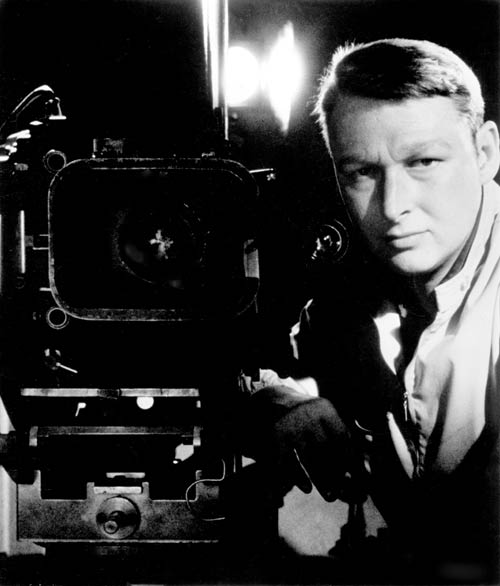 It seems fitting that director Mike Nichols’ company is called Icarus Productions. During his career as a director, theater impresario, satirist, teacher, acting school founder and blogger, Nichols has always attempted to soar above the average and ordinary. His first feature was an adaptation of Edward Albee’s Broadway hit Who’s Afraid of Virginia Woolf? in 1966 with the dream cast of Richard Burton and Elizabeth Taylor. It marked a debut that not only led to his first DGA and Oscar nomination, but also launched a run of smart and sharply insightful pictures—The Graduate, Catch-22, Carnal Knowledge—that captured the era’s sense of absurdity and uneasiness unlike anything else.
It seems fitting that director Mike Nichols’ company is called Icarus Productions. During his career as a director, theater impresario, satirist, teacher, acting school founder and blogger, Nichols has always attempted to soar above the average and ordinary. His first feature was an adaptation of Edward Albee’s Broadway hit Who’s Afraid of Virginia Woolf? in 1966 with the dream cast of Richard Burton and Elizabeth Taylor. It marked a debut that not only led to his first DGA and Oscar nomination, but also launched a run of smart and sharply insightful pictures—The Graduate, Catch-22, Carnal Knowledge—that captured the era’s sense of absurdity and uneasiness unlike anything else.
In those films and others, including Silkwood, a torn-from-the-headlines biopic of a nuclear energy whistleblower, and his HBO adaptation of Tony Kushner’s myth-shattering Angels in America, Nichols has challenged the status quo regarding hot-button issues of personal politics, gender roles and sexual boundaries. For his efforts, he has won the DGA’s Lifetime Achievement Award and best director honors twice (for Angels in America and The Graduate). Even today, the influence of his early groundbreaking films continues to touch a new generation: echoes of The Graduate can be seen in dozens of Gen-Y films such as Wes Anderson’s Rushmore and Zach Braff’s Garden State.
Even at 74, it wasn’t easy to catch up with a still soaring Nichols. He was in the midst of casting Charlie Wilson’s War, his latest excursion into politically provocative territory, about covert aid given to Islamic mujahideen fighting the Russians in 1980s Afghanistan, starring Tom Hanks and Julia Roberts. He was reluctant to offer details of the project, but then he has always preferred to let his films speak for themselves.
JEFFREY RESSNER: It seems you don’t enjoy these kind of discussions, going over various shots and styles and so forth. In fact, you’ve said that it’s not the filmmaker’s job to explain his technique, only to do the best job he can. Why don’t you like talking about it?
MIKE NICHOLS: I really can’t tell you why. It feels personal. In the beginning of course, especially in Virginia Woolf, I paid strict attention to it. The very first day of shooting the very first scene, I said I’d like to shoot [Elizabeth Taylor and Richard Burton] coming in the door, see their faces as they pass the camera, and then let them go down the hall and let them do what they do. The DP said, how about if I just track along and we see them and we don’t see them and we see them. And I said what would that be for? And he said, well, it would be interesting. I said, yeah, but it’s not what’s happening. They’ve come home drinking and discouraged and bugged with each other. Whatever we do has to express that. And I realized on the first day that I would have to be the one who decides what the shot is and how the camera moves because, in the end, I was the only one who knew what was happening. You know, the camera expresses the event. But by and large I now follow my instinct. I know what I want to see. And I can decide on the lens when we’re there and how far I want to track and when I want to pan and when I want to let them go and all of that, but it’s so intricately connected with the feelings of the characters and with the things you don’t speak about—the insides of the feelings of the characters.
Q: You come from a rich background in stand-up comedy and theater, but what were your favorite movies as a kid?
A: Well, everything. I loved all movies, literally. I certainly loved Shane and Roxie Hart. Later on, when I was less of a kid, I loved L’Avventura and Persona and all Fellini movies and like everybody else I loved John Ford. Then and now, I loved Preston Sturges, maybe above anyone. Billy Wilder and Willie Wyler were extremely helpful and generous when I came to Hollywood—I learned so much from watching them. Technically, maybe I learned most of all from George Stevens and among his movies I learned the most from A Place in the Sun. It’s a lesson in moviemaking.
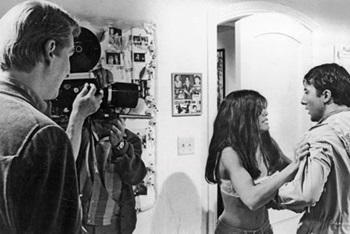 DRAMATIC MOMENT: Nichols observes Dustin Hoffman trying to win
DRAMATIC MOMENT: Nichols observes Dustin Hoffman trying to win
back Katharine Ross in The Graduate. (© Embassy Pictures/Getty Images)
Q: You studied early on with the great acting teacher Lee Strasberg. Did you see a lot of theater as a teenager?
A: I had a high school girlfriend whose mother gave us theater tickets, so I saw the second night performance of A Streetcar Named Desire. My girl and I could not get up during intermission, we were so stunned. To this day it’s the only thing I’ve seen on stage that’s 100 percent real and 100 percent poetic simultaneously. That’s what Kazan could do. When you see Kazan’s work you’re seeing people in the course of their lives, they are alive, these things are actually happening before our eyes... The reason I went to Strasberg is I didn’t know I was going to be a director or an actor or what the hell I was going to do. I knew this process fascinated me. I went for about two years, and all the time I was learning about directing but didn’t know it. I never knew I was going to be a director until after Elaine May and I stopped being a comedy team. A producer asked me to direct a play called Nobody Loves Me that later changed its title to Barefoot in the Park. I said, ‘Well, let’s do it in stock and see if I’m any good at it. Also, I want that blond guy who was on Playhouse 90 last week.’
Q: Redford?
A: Yeah. On the first day of rehearsal, I thought, ‘Oh my God, look at this! This is what I was meant to do.’ It was perfectly clear that all the things that had interested me, and all the things I had learned without being able to name what they were, were in fact for this: namely, the physical expression of what was happening, and the discovery of what aspects of life would bring out both the events and the humor.
Q: You like to quote Orson Welles who famously said people could learn all the technical things about movies in a single day. What were you looking for when you first came on the set?
A: Having unconsciously and then consciously studied George Stevens and other directors, when it came time to plan what I was going to do, I saw it in terms of shots because the shot can’t be separated from the event. I only have two questions of any piece of material: ‘what is this like in life?’ And then, when you get down to the moment or the scene, ‘what is this really like?’ Throw away the conventions and the assumptions: when this happens in life, what is it really like? And then the question for the camera is, where is it to show what it’s really like?
I had an interesting lesson on Virginia Woolf. It was the scene where Elizabeth is in the parking lot stalking around, smoking a cigarette and telling Richard something suddenly snapped. I had two cameras as near each other as possible shooting exactly the same scene—one on 100 and one on a 75. When we looked at the film some days later (because in those days you had to wait for the dailies to come back, especially to Massachusetts where we were), one shot was absolutely useless and the other was spectacularly good—and the cameras had been maybe two feet apart. I realized that those two feet, and sometimes two inches, could make an enormous difference. The placement of the camera is obviously different for every event, but when you’ve found it you know it and you can’t start shooting until you have found it.
Q: Who’s Afraid of Virginia Woolf? was a famous play, The Graduate a not-so-famous book. How do you pick the movies you choose to make?
A: It’s the hardest part of the process. In the end, it has to be something I feel, whether it’s true or not, that it’s meant for me, that I know more about this particular thing than most people and I know what to do. I know its secrets. It is, of course an illusion, but it’s like falling in love. You say, I know this person, I knew this person before, we understand each other. You have to have that kind of connection to a story, to a piece of writing. It’s so you can say when you’re casting, ‘No, I haven’t seen them yet—I need somebody who’s more powerful or somebody who’s harder to read.’
Q: It’s tough to imagine anyone but Dustin Hoffman as Benjamin Braddock in The Graduate, yet Charles Grodin and Redford were considered for the part, while Ava Gardner was mentioned for Mrs. Robinson. You’ve said, ‘Casting is the job as far as opening the veins is concerned.’ Do you have any hard and fast rules?
A: It changes. It’s been, I can’t say easier, but more pleasant since I’ve made my prime rule for casting, both for movies and plays, which is: NO ASSHOLES. It’s an amazing thing what a difference it makes. You have a company and you have to protect everyone—one asshole and it can all be spoiled. One person who says, ‘I’m not coming out until he’s out of his trailer.’ One person who says, ‘Well, he has five jokes in this scene and I only have one.’ One person who brings the nursery onto the set is enough. By the way, a prop man can do it too. It’s a large group, that crew and that cast, and you need people who can lose themselves in the central process and idea.
Q: You also believe that putting the crew together—‘the machine,’ as you call it—takes a quarter-century to get right.
A: Yes, for a very specific reason: especially in Hollywood, but everywhere in movies, whenever you ask about anybody else, it’s always ‘they’re a wonderful, wonderful person.’ You have to judge them yourself. As time passes, you put your group together of people you can’t do without. My group has been with me for centuries. Mike Haley, my first assistant, was the second assistant on the silliest movie I ever made, The Day of the Dolphin, but he made it possible. He’s the one who wasn’t afraid of George [C. Scott] and made George laugh and who mooned every Thursday and kept it a hilarious set. We’re still working together. There are many people in my group, at least 20. The other thing that happens is that some of them, sadly, die; some of them retire; and some of them go on other pictures.
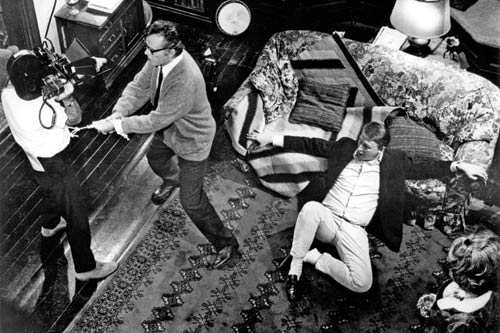 IN MOTION: Nichols has Richard Burton, attached to DP Haskell Wexler,
IN MOTION: Nichols has Richard Burton, attached to DP Haskell Wexler,
swing around the room in Who's Afraid of Virginia Woolf? (1966). (© AMPAS)
Q: One close crewmember was the late production designer and art director, Dick Sylbert. What did you learn from him?
A: Detail. It was Sylbert who said, ‘wouldn’t it be nice if Mrs. Robinson had the strap marks on her from when she was sunbathing in her bathing suit?’ And they would put those on Bancroft everyday with makeup. I could say, ‘I knew this couple at the University of Chicago and they had bookshelves made out of board and bricks.’ From that one description, he knew their entire house. It’s a question of sharing references and being able to refer to certain people you’ve known in life, and the art director saying, ‘Yes, yes, yes, I know exactly that sort of jade mug and the white enamel kitchen table it goes on.’ If he remembers it and you remember it, with luck the audience will remember it—even though they weren’t there.
Q: You brought up The Graduate and, of course, it had a groundbreaking musical score. Yet on Catch-22, your next film, you used virtually no music, something you said you probably wouldn’t do again. Is music an element you think about early on, or after you’ve made the film?
A: I start thinking about music very early or about a person I can connect with who is in music. For instance, Ry Cooder is a man who means a lot to me, and I know he’ll be able to understand what’s in my head and express it musically. With The Graduate, my brother sent me Simon & Garfunkel’s album and I used to play it when I got up very early to get to the set. At the end of the third week I said, ‘Schmuck, that’s your score!’ And of course it was. We started using it immediately while we were still shooting. We started using it as we put scenes together because it just expressed that character for me.
Q: With The Graduate, Carnal Knowledge and Catch-22, you used an array of stylish shots and amazing editing. Were you deliberately trying to push the envelope in those angles and montages, like Ben jumping on the swimming pool raft and suddenly he’s jumping on Mrs. Robinson?
A: Buck [Henry] and I built that montage image-by-image in a house I was renting here in an area we called The Stone Room. We spent about a month on it. Each shot, I knew I had to have planned because of the colors and seeming to be moving from place B to place C. We talked our way through it and bounced stuff off each other and built that long before I ever started to shoot. That’s why the preproduction period and your buddies who are making it with you are everything.
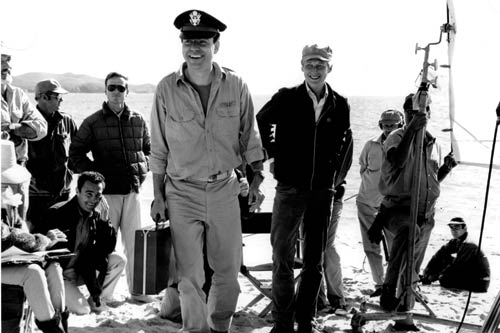 THE PLAYERS: Nichols with Alan Arkin in Catch 22 (1970). (© AMPAS)
THE PLAYERS: Nichols with Alan Arkin in Catch 22 (1970). (© AMPAS)
Q: Do you work with screenwriters that closely early on, or do you let them do their thing and later ask for rewrites and tweaking?
A: I’ve done it various ways. I prefer to be with the screenwriter a long time, telling each other the story again every day. I discovered that working on Primary Colors. Elaine May and I would tell each other the story every single day. One day I said, ‘OK, you start.’ And she said, ‘There’s a guy who runs for president,’ and I said, ‘Wait, wait, wait. There’s a phrase you have to use before you go on—and he doesn’t stand a chance.’ That’s a very important phrase because that’s where it starts. Later on there’s a sexual scandal and he becomes very famous and, by god, now he has a chance because he licked the scandal part and he’s famous. But if you don’t have and he doesn’t stand a chance, then you’re not telling the story. And you don’t have a principle we call MGM Telephone.
Q: What’s that?
A: Dan Dailey, who replaced Walter Matthau in The Odd Couple, told us he was a contract player at MGM. I asked what they taught him there, what courses did he get. He said, ‘Well, of course, posture and elocution and telephone.’ I asked what they taught in Telephone. He said, ‘they taught us if we’re doing a scene on the phone in which we’re going to get good news, then we should answer sad. And if we’re going to get bad news, answer happy.’ That’s the very core of acting: you have to be going as hard as you can in one direction in order to have us see you turned by what next hits you. That’s drama, that’s what we’re looking for.
Q: Drama also counts on little bits of business. When Julia Roberts had a big exit scene in Closer, you told her to get ready for leaving the house, picking up her things and whatnot so the dialogue would have more impact than just a straight monologue.
A: That’s the job: how is what is happening being expressed through behavior. Then there are all the subliminal expressions. When people are connected or getting turned on by each other, I keep them in the same shot or I do over-the-shoulders. If they’re separating or separated, I shoot them separately. Each has his own shot looking at the other. That’s what I mean by expressing what’s happening in your camera choices.
Q: You come from an improvisational comedy background, so do you encourage improv in rehearsals or on the set? Or do you stick to the script?
A: My basic assumption is there’s nothing an actor can think of in the heat of the moment that is going to be as clear and expressive as a great, first-class writer saying the same thing. I don’t believe in changing dialogue because the actor got it half-right. If you’ve got a good script, part of your job is to say the words as written and to make it seem as though you just thought of them. I have many improvised scenes but they don’t seem to be full of words. For instance, I wanted a scene in Working Girl that expressed Melanie and Harrison’s happiness living together. It was one of the last scenes and was shot in this little kitchenette where they’re buttering toast and pouring coffee and giving each other bites of what they’re eating. He gives her lunch to take to work on the first day and shows her what’s in the lunchbox. There were no words at all. It was an important scene, and it was improvised to express two people who are truly together.
Q: So your improv is more behavioral than conversational?
A: Yes, you could say that. Words are very important. And people are funny about words. People say, ‘Oh god, there’s so much dialogue.’ But they don’t say that about a fight. A fight is a fight. You never say, ‘they’ve been talking and talking.’ You say, ‘Fuck! I thought he was going to hit her.’ So a fight isn’t dialogue. A seduction isn’t dialogue. A negotiation isn’t dialogue. Those are the three essential things that happen in a scene. They’re so deeply embedded that Aaron Sorkin says he can’t begin to write a scene until he knows what the essential conflict is. My job is first to find out if it’s a fight, a seduction or a negotiation. Then, to have that happen in the scene expressed by the actors and the camera and the editing. If you do it right, nobody will think about dialogue. All About Eve is probably the best example of that. You never think of it as just all talk because something exciting or dramatic or funny is always happening.
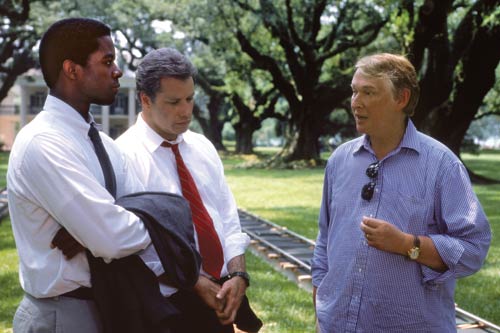 Nichols with Adrian Lester and John Travolta in Primary Colors (1988).
Nichols with Adrian Lester and John Travolta in Primary Colors (1988).
(© Francois Duhamel/Universal Pictures)
Q:You took a self-imposed hiatus after The Fortune in 1975 and didn’t make another narrative feature until Silkwood in 1983. When you came back, your style seemed to change from longer takes to using more cuts.
A: I was very hung up on long takes, partly because of the people I admired so much, like Preston Sturges. I loved those walks through town with Eddie Bracken and Betty Hutton and behind them the movie theater lets out and crowds of people come onto the street. I loved watching those takes and doing them. I discovered montage obviously in The Graduate with lots of cutting in certain instances, but I loved long takes for other events. I’m still learning about—and loving—montage because I threw out all my rules and came to it late and found some excitement.
Q: Is that what you did when you came back from your hiatus? Throw out your rules?
A: Yes. Just shoot it. It’s like grammar. You and I don’t think about grammar anymore, we just say what we’re going to say. It takes a long time to digest the grammar of movies in a similar way. I don’t worry how I’m going to shoot it anymore—I just shoot it. I can decide later if I want to stay in a long time or cut a lot. It depends on what ends up happening. I now feel as though I don’t have to choose ‘will this be an evocative case?’ or whatever the fuck. I just shoot it.
Q: Well, now of course, you can add actors and things digitally if you want. Has that affected you at all?
A: Yeah, it’s wonderful and useful. If it’s the wrong season, it’s nice to come in and change some leaves on the trees to red. All the things you have to compromise on while on location can be fixed later, all the things that you can’t afford, you can create. As you may have noticed, I love very elaborate opening shots. People always ask about that opening shot in The Birdcage—well, it’s actually three shots joined to one another but you can’t tell. All that [digital] stuff is a joy. It means you can do anything you want. But my first choice is still to try to do it within the camera, because it’s organic. And cheaper. And you’re having a better time.
 HOT SEAT: Nichols and Julia Roberts work on an emotionally intense
HOT SEAT: Nichols and Julia Roberts work on an emotionally intense
breakup scene from Closer (2004). (© Clive Coote/Sony Pictures)
Q: What’s your editing and postproduction process like?
A: I’m very intimately involved, but the process has changed for me. When [Sam] O’Steen was my editor we did everything together—he was on the set, he knew what I was doing, he watched everything. My editor now on a lot of pictures, John Bloom, doesn’t want to know anything until he’s seen the film. He has a supernatural instinct for what I intended it for, what pattern I was shooting and how I wanted it cut. He’s almost invariably right. It used to be that after seeing the assembly I would have to go home to bed because it would make me so crazy. People couldn’t read my mind, I thought, and I’d have to start all over. John Bloom will send me a sequence on DVD while I’m shooting. I’ll send him my notes, but there are surprisingly few things that he doesn’t get. By the time we’re through, we pretty much have a rough we agree on, so we can run the whole thing immediately and see where our problems lie and what has to be rethought. The months of real cutting together are a joy because we start in a place where I can like it already.
Q: Do you enjoy the same compatibility with your DP Stephen Goldblatt during the shoot?
A: Yes, it’s almost telepathy by now because we’ve done it so often. We save each other’s ass all the time. He knows how I want to shoot it, and I know how he’s going to want to shoot it—it’s surprisingly close because we’re attuned to each other without even talking. We’ll make tests and decide what looks we want or—with advantages of the digital intermediate—we just shoot it and play with it afterwards. If you can’t find the exact look for a certain sequence that will have a style of its own, find it later.
Q: Is there anything—a shot, a line of dialogue, a cut—you particularly love to use?
A: Yes, there’s a line that was lost in Elaine May’s A New Leaf. It’s an interchange I put into every movie in a crowd scene. I always take it out again, but I love it so much. It’s an introduction: ‘I’d like you meet Mr. and Mrs. Daryl Hitler’ and the reply is, ‘Oh, are you with the Boston Hitlers?’ I always think it will be very good in a crowd, and I always take it out. There’s also a shot of Leni Riefenstahl’s in Triumph of the Will I’ve stolen two or three times—once in Catch-22 and later in Biloxi Blues. The truth is, I never have as many extras as Leni Riefenstahl did in the Reichstag, so it never turns out as well. Nobody notices that I’m trying to steal, because I never get close to it. But it makes me happy.
Q: You’re one of a handful of directors today who still remembers the end of the studio system. How has the business changed over the past five decades for directors?
A: Well (pause), studios are far more hands-on than they ever were, for obvious economic reasons. It’s pressure, pressure on everybody all the way down the line in a kind of general panic to spend less and spend less and spend less. They all tend to try and control everything and, as you know, you can’t control it, you can only keep in mind that there are limits as you are going. I actually like the limitations because it’s unnerving to do whatever you want, and it usually doesn’t lead to anything great. Limitations are inspiring: they lead to thinking, so I don’t mind them. But when I think back to the people we thought were monsters, like Jack Warner, in fact I had carte blanche and could do anything I wanted and nobody ever bothered me... until he threw me off the lot when we were mixing Virginia Woolf because he did that to everybody. I had to connive my way back, and I did.
 Nichols with Jack Nicholson and Michelle Pfeiffer in Wolf(1994).
Nichols with Jack Nicholson and Michelle Pfeiffer in Wolf(1994).
(© Bureau L.A. Collection/CORBIS)
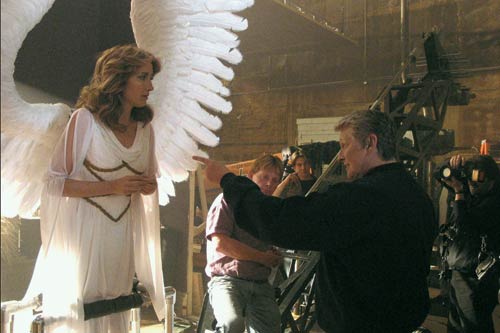 Nichols helps Emma Thompson take off in Angels in America (2003).
Nichols helps Emma Thompson take off in Angels in America (2003).
(© HBO)
Q: Is that high-pressure studio control the reason why you’ve worked with HBO on Wit and Angels in America?
A: It’s the possibility of doing smaller things you really can’t expect to be blockbuster hits in theaters. Nobody is going to see Angels in America if it’s six hours long, and it should be six hours long. And nobody’s going to pile in to see Wit and watch this woman die. It’s great to have an intelligent, if you will, elegant place to help you. I love television.
Q: Angels in America was so epic, how did you plot and plan that stage-to-small-screen adaptation?
A: Working with [playwright/screenwriter] Tony Kushner is like going to the greatest school on earth: there’s game period, and then there’s inspiration and information. We helped each other so I could envision it free of the theater before I ever started to shoot. Where would it happen? What would be happening in that place? Is it an expressive place? I got lucky by getting all the actors I dreamed of, and [cinematographer Stephen] Goldblatt, who did half the work before I even walked onto the set—everybody was already flying and all I had to say was ‘back off a little bit, let me see this or that lens, and, OK, let’s try it.’
Q: Throughout your whole career you’ve gone back and forth between film and theater, are the experiences comparable?
A: Directing movies and directing for the stage are radically different. The job is about two different things. A play is about where everybody is at any given moment, literally. Where on the stage are they all, and what does that express? Who are they and what are they doing? A movie is which character are you going to cut to for what moment. That’s how you tell the story in film. On the stage, it’s all about: where are they? She’s up by the window; he’s downstage tying his shoe. What does it express? There are two very, very different logistic problems. I love them both, and going from one to the other, and back again.
Q: One final question: On the DVD commentary for Catch-22, you talk with Steven Soderbergh about Francois Truffaut’s great observation that ‘happiness is circular, unhappiness is corners.’ Any other pearls of wisdom that you’ve picked up during your long career?
A: Sometimes I remember Jean Renoir and what I heard him say when Bogdanovich—who was perpetually interviewing him—asked, ‘What do you think of Picnic on the Grass?’ Renoir said, ‘Some of the shots were too long, and some of the shots were too short, but all in all it’s my best picture.’ I didn’t have to remind myself to remember that, because I was just so stunned by how simple he kept it. That was his greatness—he kept everything simple, even the most complex things that other people couldn’t even see. And so I think ‘keep it simple’ is a good thing to remember.